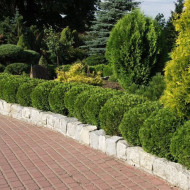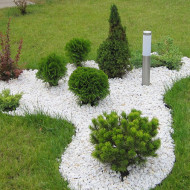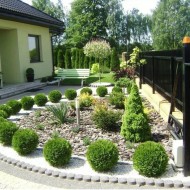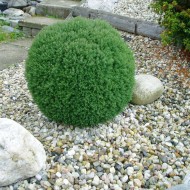Growing and options for using thuja Teddy in landscape design
Content
History and description of thuja western teddy
An evergreen shrub of the Cypress family came to Europe from the North American continent back in the 16th century. Since then, breeders have not stopped working on the creation of new varieties and hybrid forms. Thuja western Teddy (Thuja occidentalis Teddy) was bred relatively recently, but has already become popular among European gardeners.
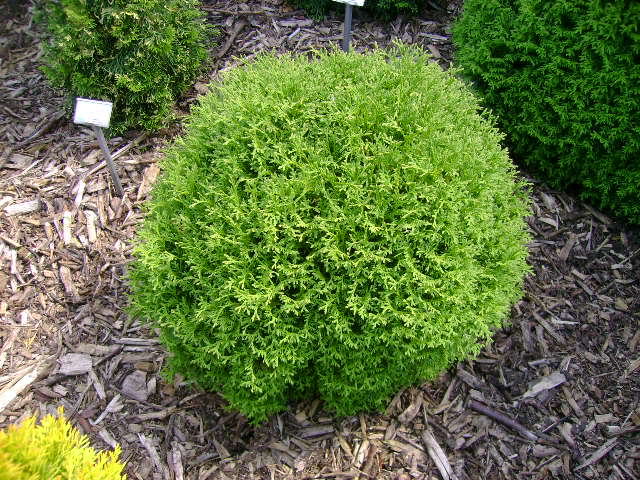
The compact hybrid is characterized by a spherical shape and soft, dense needles of an emerald green color. In winter, the color acquires a brownish tint, but turns green again with the onset of warmth. Also, the cultivar is characterized by a small annual growth - only 20-30 mm. An adult plant grows to a height of 0.3-0.5 m with a bush diameter of 30-40 cm.
Thuja Teddy is frost-resistant, calmly tolerates a drop in temperature to -32 ° C, but requires shelter for the winter. She does not like drought, and therefore needs regular watering and moisture. Since the root system of the ornamental culture is superficial, the soil around the shrub must not be allowed to dry out.
Video "Description of Tui Teddy"
This video presents the main varietal characteristics of the crop.
Coniferous crop farming rules
The "plush" coniferous hybrid does not belong to capricious plants, but the first few years require more careful attention to itself. We will talk in more detail about agricultural technology and a description of the processes below.
Site selection and soil preparation
Gardeners recommend planting Teddy in semi-shaded areas, where there is no stagnation of moisture and surface groundwater. Also, the place should be well protected from wind blowing.
The cultivar loves nutritious, moist soil with good penetrating ability. The acidity level can be neutral or slightly elevated. The hybrid is most comfortable on loam and loamy sandy soils. In this case, the substrate for planting should consist of garden soil, peat, sand, humus in a ratio of 2: 1: 1: 1.
Landing algorithm
Seedlings with a closed root system can be planted at any time except during the winter months. But the planting of seedlings without an earthen coma is carried out in early spring or with the arrival of autumn. In order for the young to start well, gardeners recommend adhering to the following algorithm:
- dig out landing holes measuring 60x60x60 cm with an interval between them of 0.4-0.5 m;
- lay out 20 cm of a drainage layer of expanded clay or broken brick;
- partially fill the hole with a previously prepared soil mixture;
- place the seedling, leaving the root collar flush with the surface;
- fill up the rest of the substrate, slightly tamping the ground;
- form a near-trunk circle, where a bucket of water is then poured;
- covered with mulch from dry needles, sawdust or peat.
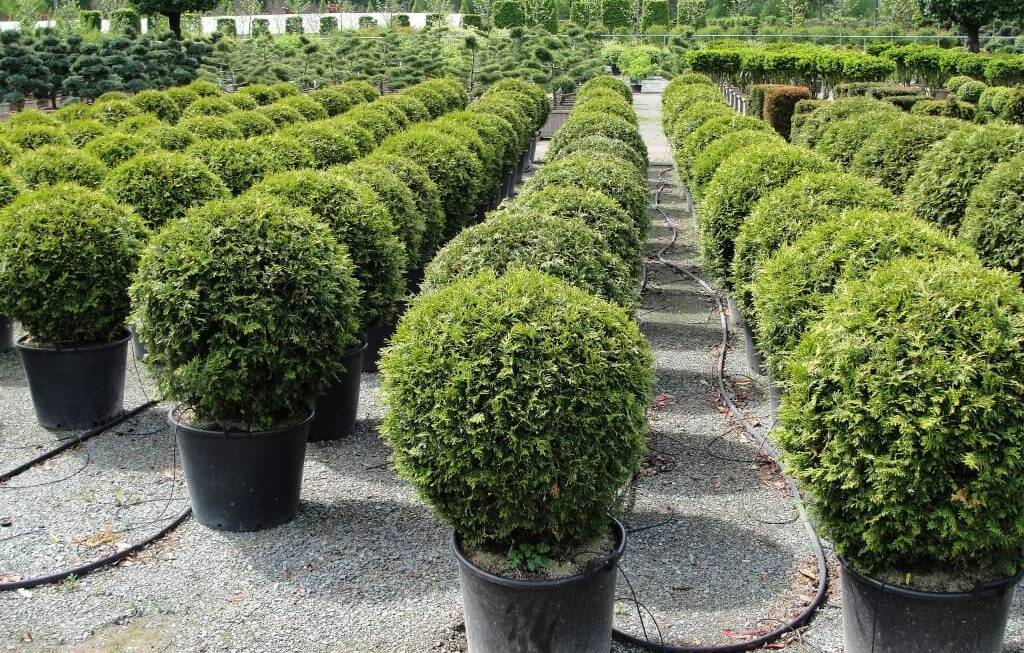
Watering, sprinkling and soil care
Moisture-loving western thuja requires competent adherence to the irrigation scheme. When growing a "plush" cultivar on your site, you must carefully monitor the condition of the soil. The soil must be kept moist at all times, but overflow is no less dangerous to the hybrid than dry soil. The norm for a plant is 10 liters per week. In extreme heat, water consumption and frequency are doubled. In summer, every day after sunset, irrigation is carried out on the green part, and in the morning they loosen the ground around the bush, remove weeds or change the mulch layer.
Fertilization
Unlike other garden plants, thuja does not need to be fertilized frequently. She needs only two dressings per season:
- April-May (use complex formulations for coniferous crops such as "Nutrisol");
- September (potassium-phosphorus preparations are introduced).
Once a year, the Teddy hybrid can be fertilized with leaf humus or peat.
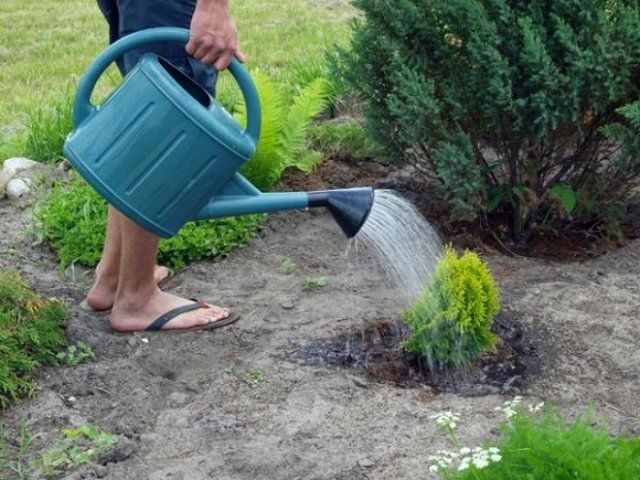
Pruning and shaping the bush
One of the features of the Teddy variety is that the bushes acquire the correct spherical shape themselves, without additional formative pruning. And although dwarf thuja tolerate a topiary haircut well, only a specialist should do it.
The procedure is carried out twice a year:
- in early spring before the start of the movement of juices;
- in the fall before wintering.
During sanitary pruning, dried or damaged branches are removed, as well as withered needles are removed.
The nuances of preparing for winter
They begin to prepare Teddy for wintering with the onset of the first frost. At the end of autumn, the soil is fed for the last time, moistened, and the trunk circle is laid out with a 15-centimeter layer of mulch from peat or tree bark. In young plants, the shoots that have not yet formed are carefully tied together so that they do not break off under the snow cap. Then the shrub is wrapped in spunbond or burlap.
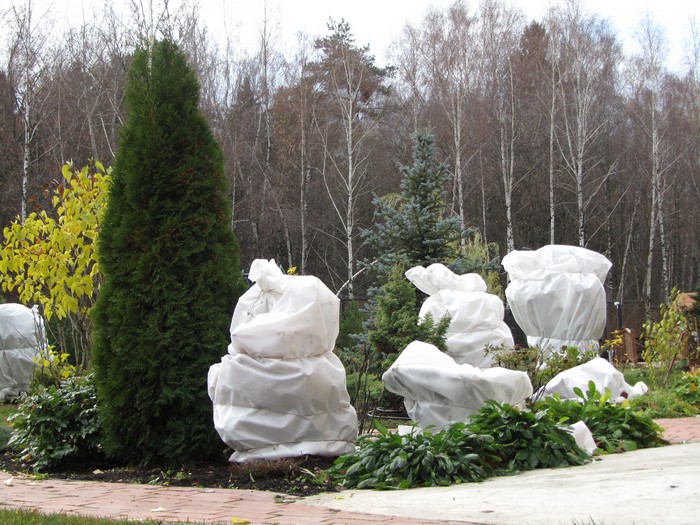
Treatment against pests and diseases
The selective thuja Teddy is rarely affected by infections, however, for prophylaxis, it is still recommended to spray the bush with Bordeaux mixture or Fundazole solution every spring. Although the risk of infection is minimal, with improper care, the culture can get sick:
- fusarium;
- rust;
- cytosporosis;
- pseudopod;
- brown shute.
At the first symptoms of infection, the plant is twice treated with fungicides such as "Hom" or "Topsin-M" with an interval of 10 days.
Pest insects also rarely settle on thuja. Having found spider mites or aphids, the cultivar should be sprayed with an insecticide solution (for example, Aktellik or Aktara). The procedure is recommended to be carried out twice in 1-1.5 weeks.
How to propagate the western thuja
Most often, seedlings for planting are purchased in nurseries, however, some gardeners prefer to propagate the hybrid themselves. The easiest way is grafting. Planting material is harvested in spring if the donor plant is annual, or in autumn if it is two years old. The procedure consists of several stages:
- from a young shoot, pinch off a process 20-30 cm long, leaving a "heel" at one end;
- the bark is carefully removed from the bottom and soaked overnight in Kornevin;
- fill the container with soil mixture (earth, peat, sand);
- the handle is stuck at a slight slope, deepening it by two fingers;
- slightly moisten the soil, and then create greenhouse conditions;
- periodically ventilate the seedling, not forgetting to irrigate the substrate;
- youngsters are seated in separate flowerpots only after the root system is formed.

A more laborious method of reproduction is by seeds. It consists in the following:
- in the fall, cones are harvested from the bush, which are then dried to obtain seed;
- ready-made seeds are kept for 2-3 months at a temperature of +5 ° С;
- after the allotted time, they are treated with a pink solution of potassium permanganate, and then sown into a container;
- a layer of sand is poured on top, moistened and covered with plastic wrap;
- the greenhouse is regularly ventilated and the substrate is irrigated;
- when the seedlings grow up a little, they are seated in separate flowerpots.
The period between sowing seeds and planting plants in open ground with this method of reproduction is 5-6 years.
The use of thuja Teddy in landscape design
The decorativeness of the dwarf shrub allows it to be used in many variations in landscape design. It will look equally good as a tapeworm or in combination with other garden plants. Examples of using:
- decoration of paths, alleys or entrances;
- the formation of hedges;
- registration of border landings;
- creation of rock gardens and rockeries;
- coniferous groups (for example, with juniper, cypress or other varieties of thuja);
- flower arrangements (blooming ornamental shrubs can be neighbors, as well as ground covers such as periwinkle, loosestrife, thyme or acena).
- Entrance group decoration
- Alpine slide in the garden
- Decoration of garden paths
- Decorative composition
- Mixborder element
- Solitary landing
Gardeners reviews
“I love coniferous crops very much, I grow them at my dacha. A recent experience was the disembarkation of a thuja Teddy. I was amazed at how easy it is to take care of the bush and absolutely no need to do formative pruning. "
“I am a landscape designer by profession. I learned about the Teddy variety a few years ago, after reading reviews on the gardeners forum. Since then, I have been actively using this thuja in my work, since her decorative qualities are really at their best, but at the same time she is not whimsical at all. "
Thuja occidentalis Teddy, like all artificially bred hybrids, has a lot of positive qualities. However, only this variety has a "plush" appearance and a correct, self-forming crown.



